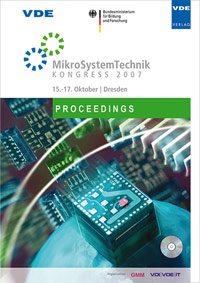Tactile CMOS-Integrated 3D Force Sensor System
Konferenz: MikroSystemTechnik - KONGRESS 2007
15.10.2007 - 17.10.2007 in Dresden, Germany
Tagungsband: MikroSystemTechnik
Seiten: 4Sprache: EnglischTyp: PDF
Persönliche VDE-Mitglieder erhalten auf diesen Artikel 10% Rabatt
Autoren:
Gieschke, P.; Levey, B.; Doelle, M.; Trautmann, A.; Ruther, P.; Paul, O. (Microsystem Materials Laboratory, Department of Microsystems Engineering (IMTEK), University of Freiburg)
Inhalt:
This paper reports on a CMOS-integrated three-axial force sensor system realized using a low-temperature post- CMOS compatible process. The sensor system is based on a micromechanical cross structure realized by twosided deep reactive ion etching (DRIE) of individual IC chips comprising piezoresistive transducers integrated with on-chip circuitry. The silicon cross structure is suspended over thin membrane hinges within a rigid silicon frame. Upon application of forces to a tactile element attached to the cross centre, the membrane hinges are deformed. This is monitored using piezoresistive transducers based on field effect transistors (piezo-FETs) with four source/drain contacts exploiting the pseudo-Hall effect. The integrated circuitry applies a serial I2C bus and contains a switched-capacitor amplifier and a 10-bit successive-approximation AD converter. A digital logic block extracts the second-order Fourier component of the sensor signals representing mechanical stress. In comparison to the first generation of this sensor, the integration of on-chip circuitry is expected to reduce electromagnetic interference and the cost for off-chip electronic instrumentation. The post-CMOS micromachining is able to process individual CMOS chips handled, aligned, and etched on a wafer chuck comprising cavities realized by DRIE. The alignment accuracy within these cavities is better 10 µm. Initial testing of the system was performed applying out-of-plane vertical forces to the central part of the cross structure while monitoring its displacement. The sensor output is recorded using the serial interface. For displacements below 15 µm, a linear sensor response is elicited from the piezo-FETs. From these measurements, it is concluded that a resolution of 33 nm for out-of-plane displacements can be achieved.


